
The Bottom Line
Introduction and Package
Introduction of the ASUS GTX 970 4GB STRIX OC
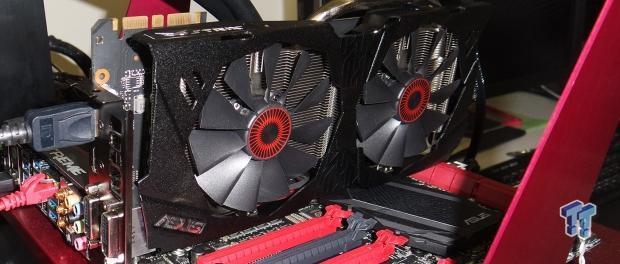
It's been a long week and half as I took the time to upgrade our aging video card testbed. While the X79 platform is fantastic and continues to be a great performer, it just made sense for us to make the move over to the new X99 platform. Moving to the new X99 platform not only bought an upgrade in components, but also an upgrade in our benchmark line up.
Upgrading both our hardware and benchmark line up is always fantastic, but it also means that we have to scrap the results of everything we've tested before, and that's a lot of video cards. To give you an idea, the results of 196 video cards can no longer be used on our temperature, noise, and power graph. Although, we're also changing the way we test that from now.
We'll cover our testbed and the benchmarks a little later on; for now, let's briefly talk about what we're testing today. The first video card that's going to be tested on our new setup is the ASUS GTX 970 4GB STRIX OC. The STRIX series is one of the more recent additions to the ASUS line up, and we originally saw the series show up during Computex. Not too long ago, we had a chance to look at a GTX 700 series version of the card, and we found ourselves very impressed with what ASUS offered in the new series.
One of the biggest benefits is that the fan doesn't spin when the card is under low load. While this feature is showing up more and more these days, one of the biggest benefits about the STRIX version was that it wasn't just reserved to when the card was idle. In a gaming situation where the video card isn't too taxing, the fan will refrain from spinning. At Computex, we saw this work when the GTX 780 version was running StarCraft II and the fans did not spin.
Let's leave it at that, though, and move forward to see exactly what ASUS is offering with the GTX 970 4GB STRIX OC video card.
Package - What comes inside the box
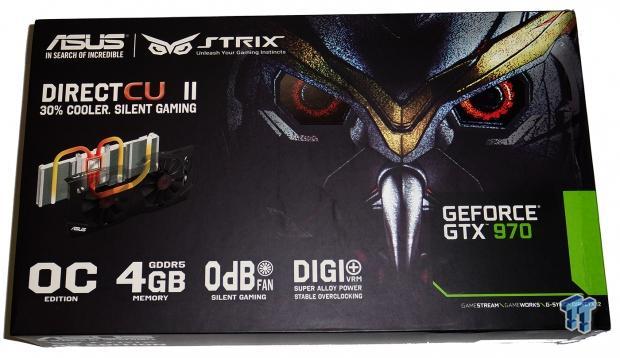
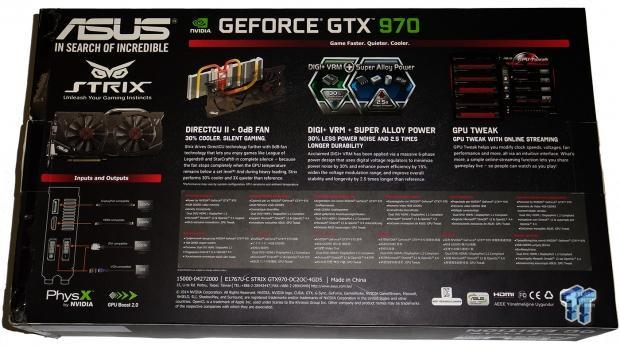
Looking at the box, we see the overall design is similar to the GTX 780 STRIX card we looked at, with the main difference being the image depicted. Instead of the claw marks, we have an almost robotic owl here. The main feature shown is the DirectCU II cooler. Some of the other major features noted include the fact it's an OC Edition, it carries 4GB of GDDR5, and DIGI+ VRM.
Turning the box over, you can see ASUS goes into some more detail on the card. On the left hand side, you can get a look at the card. Below that, we can see the connectivity options that are offered; we'll take a closer look at this on the next page.
As for the other big features, we've got the DirectCU II cooler, which allows the card to run 30% cooler while also offer silent gaming. DIGI+ VRM brings 30% less power noise, and 2.5x longer durability via a six-phase power design, which uses digital voltage regulators. The other main feature is the GPU Tweak software, which not only gives you the ability to overclock, but also the ability to live stream your gaming.
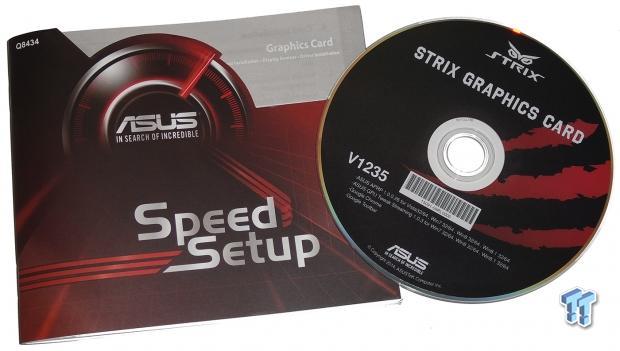
Looking at the bundle, you can clearly see it's a little on the light side, with just a speed setup guide, and driver CD included. Like most companies, though, this setup is becoming fairly standard, since most companies choose to concentrate on the product itself, instead of unnecessary bundle items.
PRICING: You can find the ASUS STRIX-GTX970-DC20C-4GD5 Graphics Cards STRIX-GTX970-DC20C-4GD5 for sale below. The prices listed are valid at the time of writing but can change at any time. Click the link to see the very latest pricing for the best deal.
United States: The ASUS STRIX-GTX970-DC20C-4GD5 Graphics Cards STRIX-GTX970-DC20C-4GD5 retails for $452.06 at Amazon.
Canada: The ASUS STRIX-GTX970-DC20C-4GD5 Graphics Cards STRIX-GTX970-DC20C-4GD5 retails for CDN$784.99 at Amazon Canada.
Video Card Details and Specifications
Close-up with the ASUS GTX 970 4GB STRIX OC
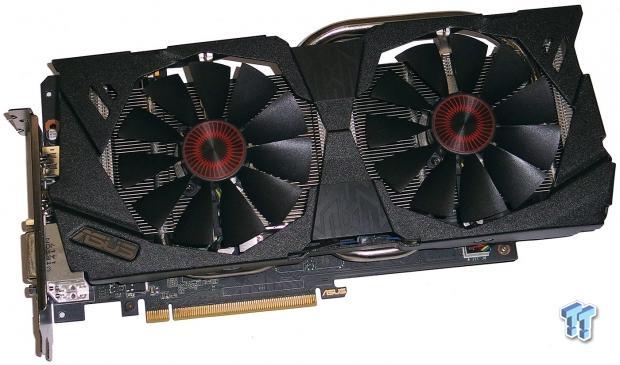
Looking at the card, you can see the overall design is very similar to the GTX 780 version of the STRIX card we looked at a few months back. The large dual fan cooler covers the majority of the PCB, and then some, as it shoots over the edge. We've got a massive heat sink sitting behind the two fans, and looking closer, you can see we've got a number of heat pipes coming out of the top and bottom of the card to help draw that heat away from the core.
The DirectCU II STRIX cooler did a good job last time we looked at it, and we're expecting it to continue to do very well on the new Maxwell based GPUs.


It's interesting to find that ASUS is offering just a single eight-pin power connector here. The reference GTX 970 4GB design comes with a dual six-pin PCIe connector setup. The MSI GTX 970 Twin Frozr V Gaming OC card we looked at went slightly up on this with a single six-pin and single eight-pin PCIe connector. However, for people wanting a video card that doesn't draw too much power, and still manages to offer strong performance, this could be a great option. We'll see just what kind of power draw numbers the card offers a little later on.
Moving closer to the front, you can see our two SLI connectors. Because of the larger cooler, you can see that ASUS has actually extended the PCB here, so you can use three card setups without any problems. While this addition is small, it is a thoughtful addition for people wanting a multiple video card setup.

Here you can see that we've got two Dual Link DVI connectors in the form of a single DVI-I and DVI-D. Along with that, we've also got a full-size HDMI, and full-size DisplayPort connector. As a heavy DisplayPort user, I must admit I prefer the reference design, which includes a single Dual-Link DVI and HDMI port alongside three full-size DisplayPort connectors.
Specifications
As we saw on the front of the box, we're dealing with an OC version of the GTX 970 4GB. Out of the box, the reference GTX 970 4GB comes with a 1050MHz core clock that is then boosted to 1178MHz. The 4GB GDDR5 comes in at 7000MHz QDR. However, looking below, you can see that ASUS has increased the clock speeds of the cards as you'd expect.
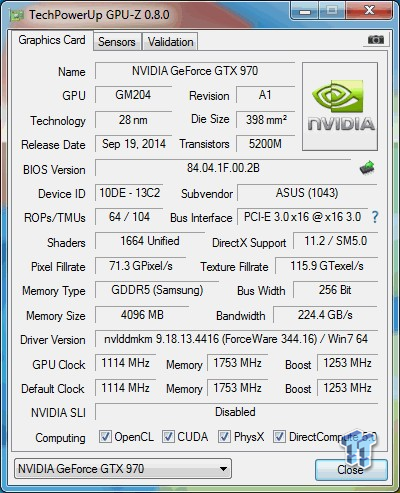
As for the core, that has been kicked up to 1114MHz, which is then boosted to 1253MHz. The 4GB of GDDR5 comes in at the stock 7012MHz QDR clock. This isn't a huge surprise, and we see most companies ignore the memory clock, and instead opt to push the core clock higher.
Test System Setup & FPS Numbers Explained
Test System Setup
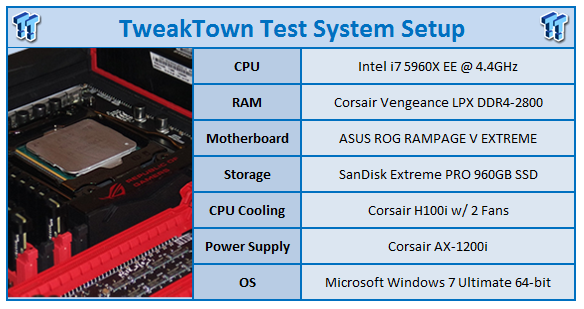
We would like to thank the following companies for supplying and supporting us with our test system hardware and equipment: Intel, ASUS, and Corsair.
Normally I would not cover the testbed, and just move into talking about the cards in our graphs, but because we're dealing with a total upgrade today, I'll quickly go over some of the major changes. Of course, the biggest change is the move to the X99 platform, which brings the X99 based ASUS RAMPAGE V EXTREME. This is paired with DDR4 RAM, which, in this case, is the Corsair Vengeance LPX DDR4-2800MHz DDR kit.
In the center of all this sits the Intel i7 5960X Extreme Edition, which is overclocked to a solid 4.4GHz. Finally, the other major change to the system comes in the form of the SanDisk Extreme PRO 960GB SSD. Not only is this SSD damn fast, but it's also got an absolute ton of storage. With some games coming in at 40GB+ these days, our aging 256GB SSD just couldn't keep up.
As for what's included in our graphs here today, they're a little on the light side as our ASUS GTX 970 4GB STRIX OC sits alongside the HIS R9 290X 4GB. Thanks to recent price drops on the AMD video card line, the R9 290X 4GB now comes in at the mid $300 price range, which lines up with the GTX 970 4GB. There's really not a fairer contender, as these two cards are almost the exact same price.
As we mentioned in our introduction, alongside the testbed upgrade, the benchmark lineup has also been modified to remove some older games and bring in some newer ones. While our benchmark line up is constantly changing, this is the biggest upgrade we've had to do in some time. However, instead of going into any more detail on the changes, let's just see them as we move forward with the review.
The FPS Numbers Explained
When we benchmark our video cards and look at the graphs, we aim to get to a certain level of FPS which we consider playable. While many may argue that the human eye can't see over 24 FPS or 30 FPS, any true gamer will tell you that as we climb higher in Frames per Second (FPS), the overall gameplay feels smoother. There are three numbers we're looking out for when it comes to our benchmarks:
30 FPS - It's the minimum number we aim for when it comes to games. If you're not dropping below 30 FPS during games, you're going to have a nice and smooth gaming experience. The ideal situation is that even in a heavy fire fight, the minimum stays above 30 FPS, making sure that you can continue to aim easily, or turn the corner with no dramas.
60 FPS - It's the average we look for when we don't have a minimum coming at us. If we're getting an average of 60 FPS, we should have a minimum of 30 FPS or better, and as mentioned above, it means we've got some smooth game play happening.
120 FPS - This is the newest number that we've been hunting down over recent months. If you're the owner of a 120 Hz monitor, to get the most out of it, you want to get around the 120 FPS mark. Moving from 60 FPS / 60 Hz to 120 FPS / 120 Hz brings with it a certain fluidity that can't really be explained, but instead has to be experienced. Of course, if you're buying a 120 Hz monitor to take advantage of 3D, an average of 120 FPS in our benchmark means that in 3D you will have an average of 60 FPS, which again means you should expect some smooth gameplay.
Why are some graphs incomplete?
Adding new game benchmarks is a long, tedious, and time consuming task, as every video card has to be re-tested in those new benchmarks. For that reason, we have always just reevaluated our benchmark line up every six months. To stay up-to-date and current with the latest benchmarks and games available, we've changed our approach to adding new benchmarks.
Our benchmark line up will progress and be updated as newer, more intensive games with benchmarks comes to light. While this will mean that initially you may only see a single video card in those particular graphs, as the weeks go on and we test more and more video cards, the results will quickly grow. This will help keep our benchmark line up as up-to-date as possible as we introduce and remove games on a constant basis.
Benchmarks - 3DMark
3DMark Fire Strike
Version and / or Patch Used: 1
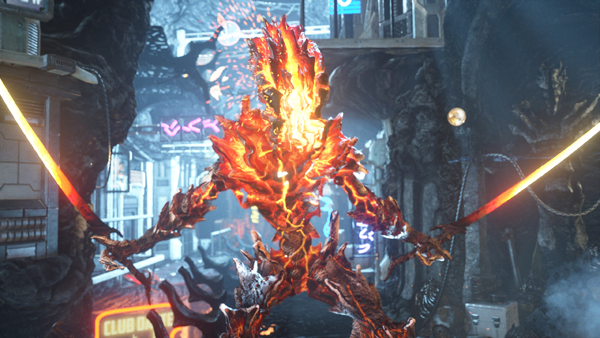
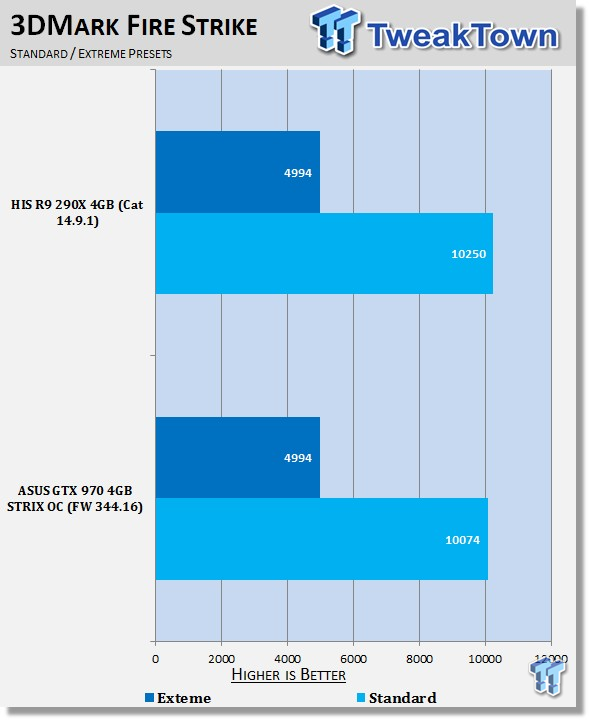
Starting off with 3DMark Fire Strike, you can see that the cards perform quite close to each other in both tests, with the Extreme preset actually being identical. Let's move forward and see if we can get some separation.
3DMark Sky Diver
Version and / or Patch Used: 1.1

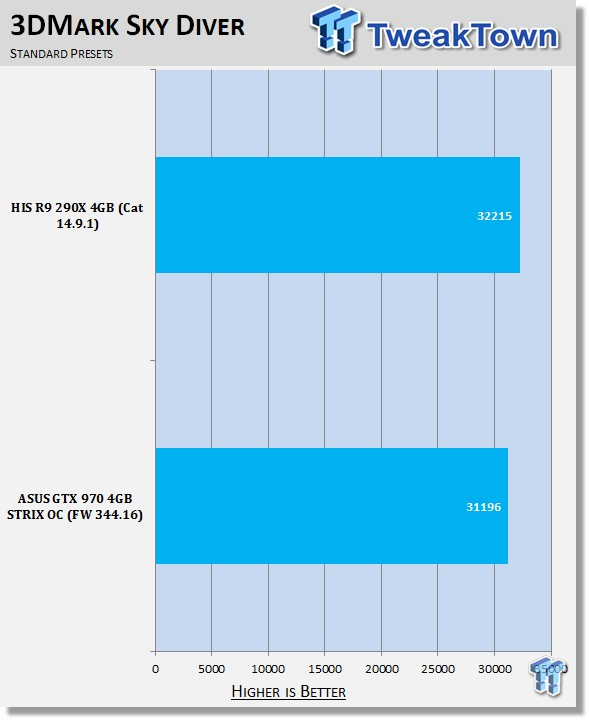
Sky Diver is a benchmark that mainly focuses on mid-range cards, and because of that, we see higher-end cards perform quite close to each other. While looking above, you can see the R9 290X 4GB manages to sneak out ahead; the overall difference is quite minor.
Benchmarks - Catzilla & Unigine Heaven
Catzilla
Version and / or Patch Used: 1.3

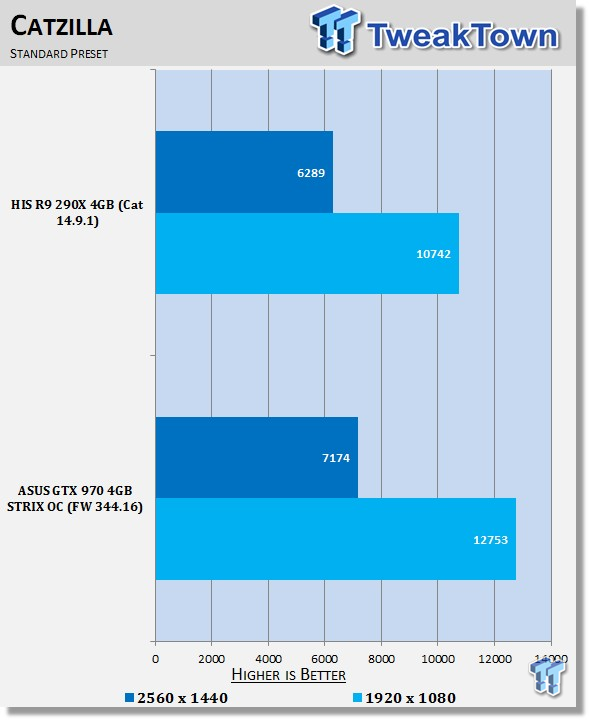
Looking at Catzilla performance, you can see we have quite the difference between the two setups. Here you can see that the new Maxwell based GTX 970 from ASUS performs significantly better at both of these resolutions.
Unigine Heaven Benchmark
Version and / or Patch Used: 3
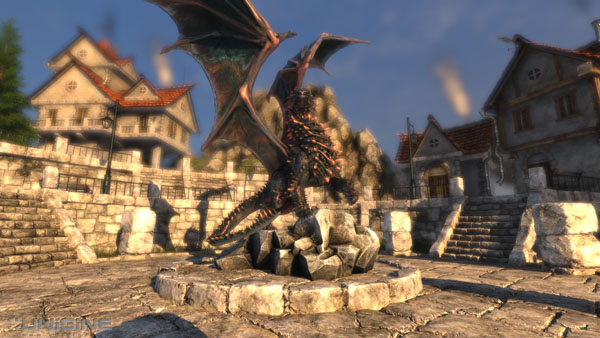
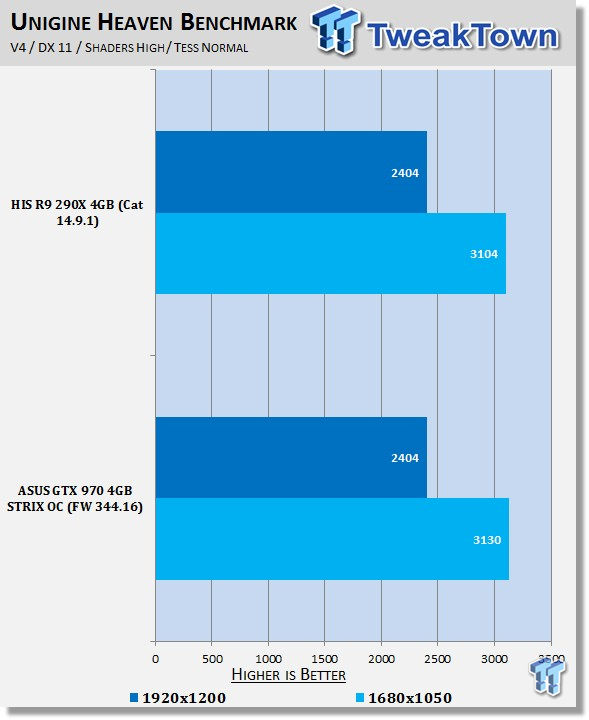
Moving into Heaven, you can see that both cards again score very close to each other, with the 1920 x 1200 resolution giving the exact same score on both cards.
Benchmarks - Unigine Valley & Just Cause 2
Unigine Valley Benchmark
Version and / or Patch Used: 3

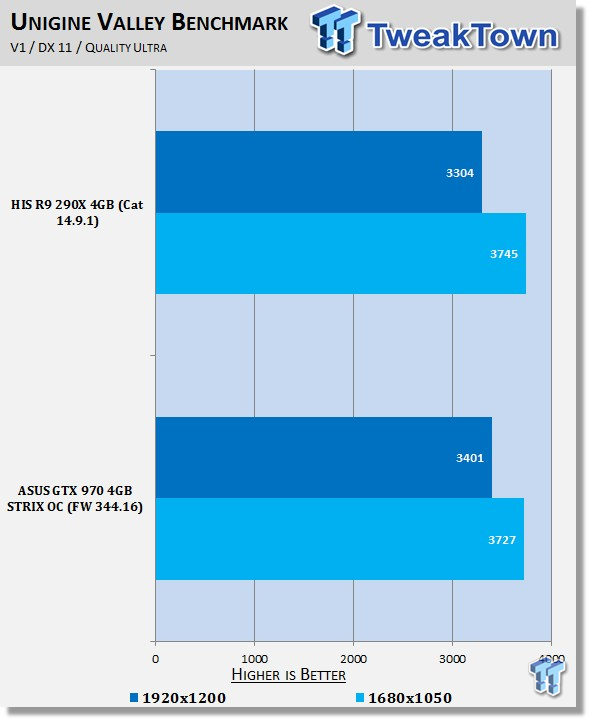
Looking at one of our newer benchmarks, Unigine Valley, you can see that at 1680 x 1050, both setups are very close to each other. However, once we move to the higher resolution, we see the ASUS GTX 970 4GB STRIX OC come out ahead.
Just Cause 2
Version and / or Patch Used: Latest Steam Update


While Just Cause 2 is getting a little old, we hadn't run the game at its highest settings. Looking above, you can see that when it's maxed out, Just Cause 2 puts quite the hurt on modern day video cards. However, the AMD offering does hit a wall at the mid 80 FPS range.
Benchmarks - Metro: Last Light & Sleeping Dogs
Metro: Last Light
Version and / or Patch Used: Latest Steam Update

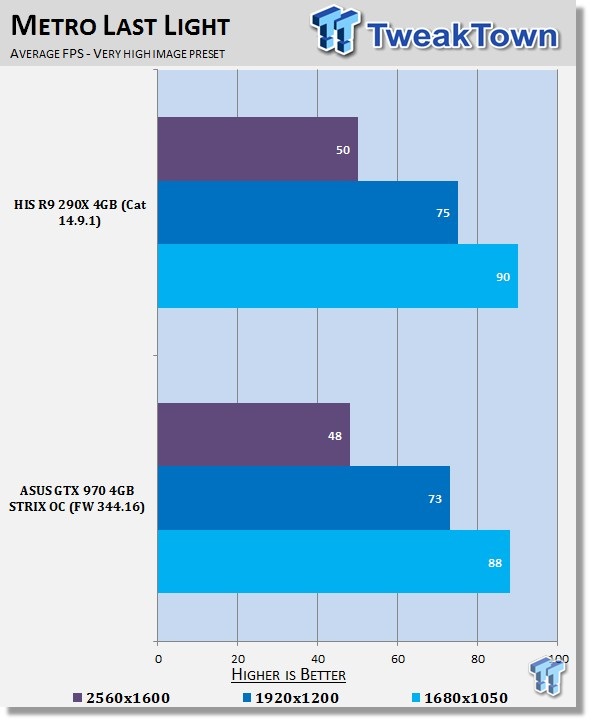
Metro: Last Light doesn't see too much difference between the two setups. While the R9 290X 4GB does manage to come out ahead at all resolutions, it's only by two FPS each time. The game also becomes unplayable at the higher 2560 x 1600 resolution, as we come in at under 60 FPS.
Sleeping Dogs
Version and / or Patch Used: Latest Steam Update


Sleeping Dogs performance is heavily in favor of the ASUS GTX 970 4GB STRIX OC here, with solid FPS shown at all resolutions. At the lower resolutions, we also see that the AMD R9 290X 4GB sits fairly far back due to a wall being hit at around 140 FPS. The same issue isn't seen with our NVIDIA card, as the 1680 x 1050 average manages to sneak just past 200 FPS.
Benchmarks - Hitman: Absolution & Tomb Raider
Hitman: Absolution
Version and / or Patch Used: Latest Steam Update
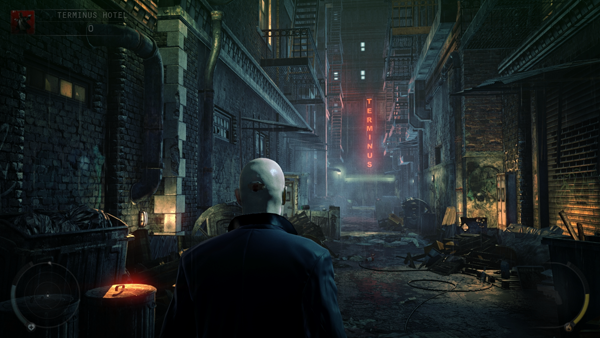
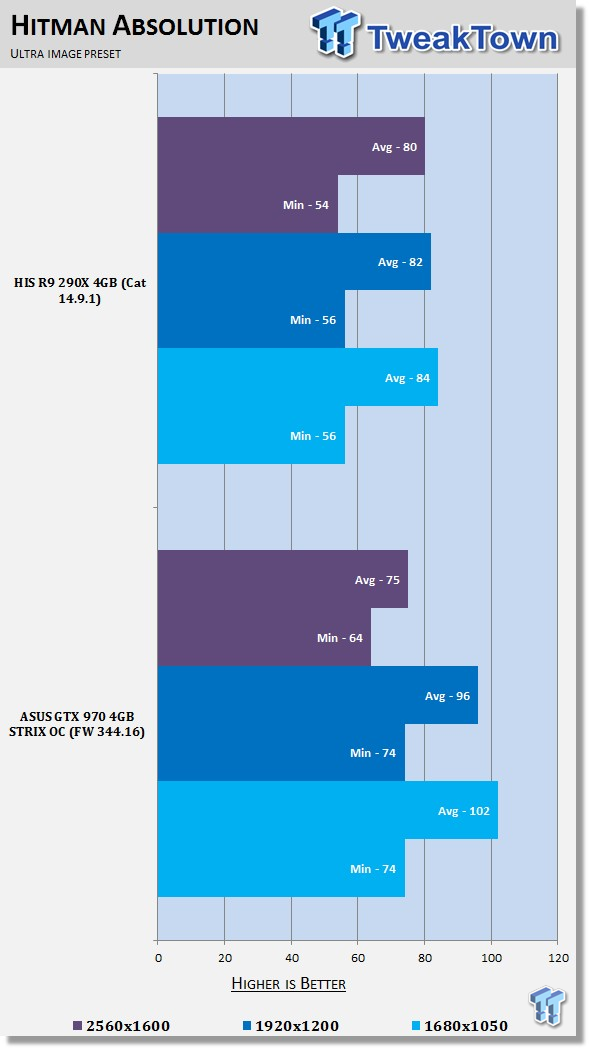
Hitman: Absolution tends to favor the NVIDIA offering again, thanks to the FPS wall being hit at a later stage than the AMD. While we have gotten solid FPS across the board, there's no denying that we'd prefer the higher numbers offered by the ASUS GTX 970 4GB STRIX OC.
Tomb Raider
Version and / or Patch Used: Latest Steam Update

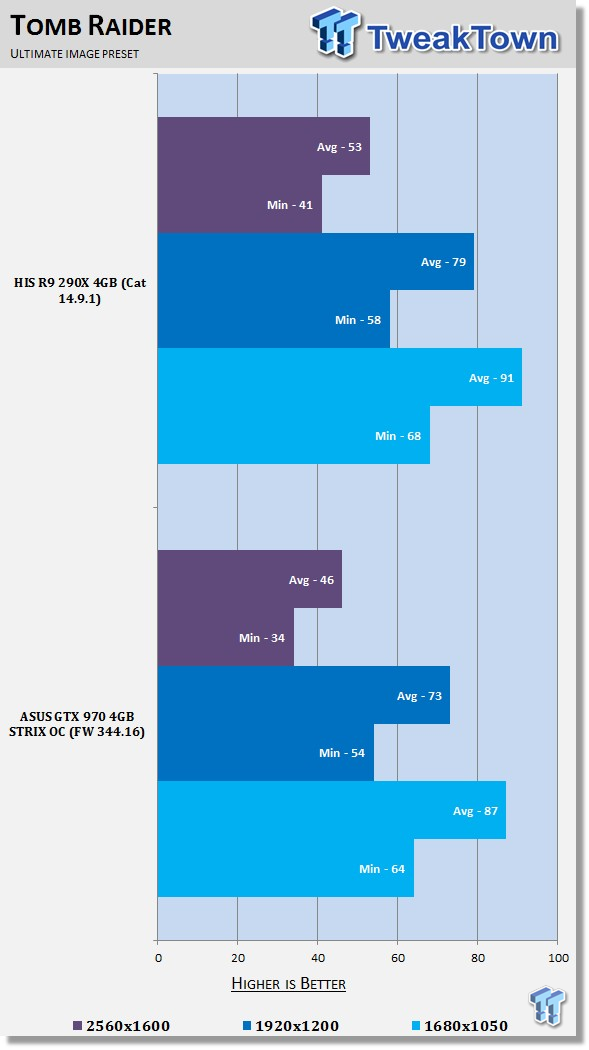
Across the board, Tomb Raider performance slightly favors the AMD offering by a couple of FPS at all resolutions. With that said, you can see that both setups offer playable numbers at the lower resolution, while at 2560 x 1600 we fall short of that 60 FPS average we're on the hunt for.
Benchmarks - BioShock Infinite & Battlefield 4
BioShock Infinite
Version and / or Patch Used: Latest Steam Update

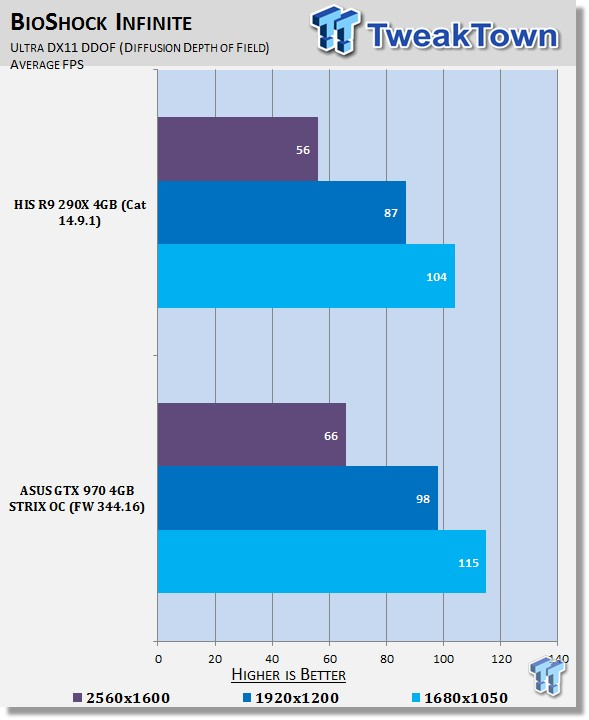
BioShock Infinite performance favors our ASUS GTX 970 4GB STRIX OC. The best gain is seen at 2560 x 1600, though, where the HIS R9 290X 4GB falls short of that 60 FPS average we want with a 56 FPS average. On the other hand, the ASUS GTX 970 4GB STRIX OC sees a solid performance boost, which helps bring in a 66 FPS average.
Battlefield 4
Version and / or Patch Used: Latest Origin Update


While solid performance from both cards is shown across the board, you can see that the ASUS GTX 970 4GB STRIX OC manages to have a clear performance gain at all resolutions. These gains are going to be appreciated in those massive 64 player games when everything start to get crazy.
Benchmarks - GRID Autosport
GRID Autosport
Version and / or Patch Used: Latest Steam Update
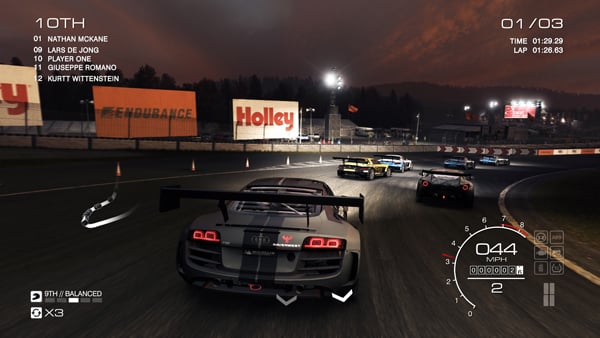

Thanks to the FPS wall being hit quite early on, you can see that the ASUS GTX 970 4GB STRIX OC clearly manages to come out ahead at the lower resolutions. Although, when we move to 2560 x 1600, the FPS wall doesn't come into play. Here you can see the ASUS GTX 970 4GB STRIX OC still manages to come out ahead by a solid 10%+.
F1 2014
Version and / or Patch Used: Latest Steam Update
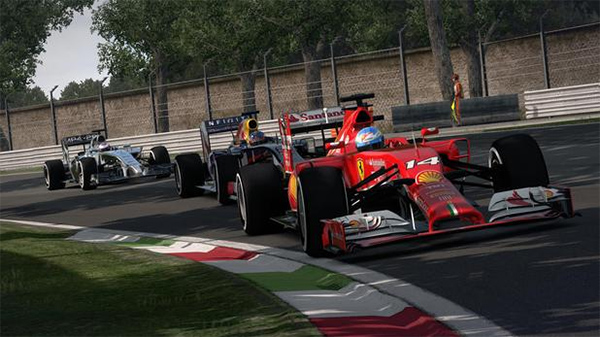

Looking at one of our new benchmarks, F1 2014, you can see that a FPS wall is hit on these higher-end cards at the mid 120 FPS mark. This is a solid number, though, which is still perfect for people using a 120Hz monitor.
Benchmarks - Middle-earth: Shadow of Mordor
Version and / or Patch Used: Latest Steam Update

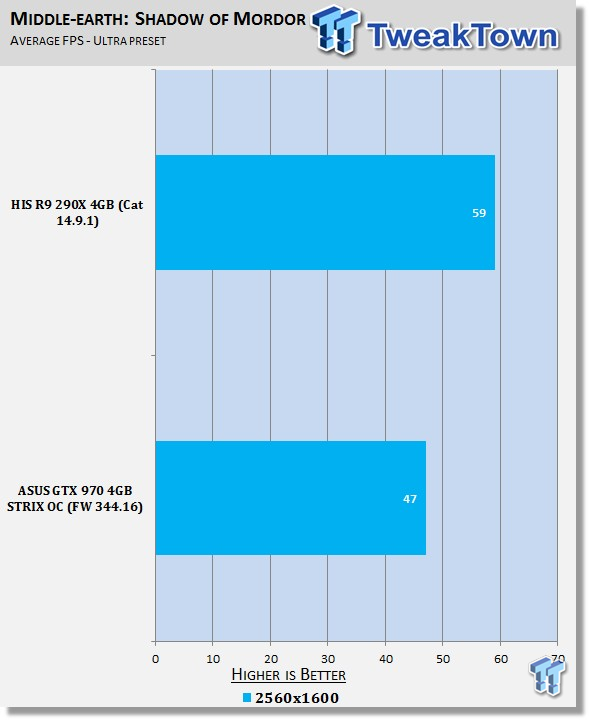
When it comes to Shadow of Mordor, you can see the AMD R9 290X 4GB has a significant lead over the ASUS GTX 970 4GB STRIX OC here, with an average of 59 FPS shown at the highest resolution.
Benchmarks - High Quality AA and AF
High Quality AA and AF Testing
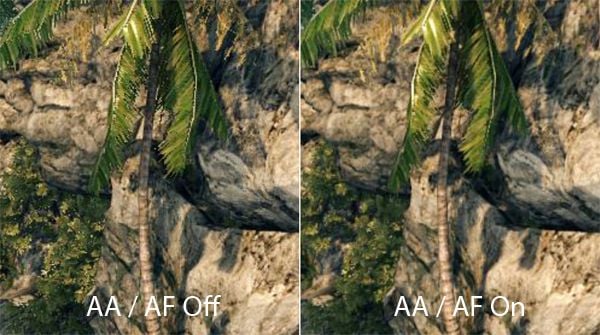
While we test all our games with maximum in-game settings, turning on Anti-Aliasing (AA) and Antistrophic Filtering (AF) helps take the intensity of our testing to another level.
Here we see video cards go from playable FPS to unplayable FPS, and the real power houses continue to help break that 60 FPS mark we always aim for to provide a smooth gaming experience.

Looking above, you can see that both setups give nearly identical numbers, but when it comes to turning on AA and AF, the overall FPS are just too low.

Looking at GRID Autosport, you can see that while the R9 290X 4GB does manage to sneak slightly ahead at both resolutions, both setups manage to offer playable FPS at over 60 at both resolutions.

With AA and AF on, we again see nearly identical numbers from both setups. When it comes to playability, though, you can see that 1920 x 1200 numbers are solid, with a 64 FPS average shown by both cards. However, 2560 x 1600 isn't an option, as we see numbers only in the high 30s.
Benchmarks - 4K - 3840 x 2160 Testing
4K - 3840 x 2160 Testing

4K monitors are the next step for gamers demanding the best in image quality. With 4x the pixels of a standard 1920 x 1080 monitor (meaning 4x the intensity), 3840 x 2160 brings a new level of intensity to video cards.
To make sure that you're buying the right video card for a monitor that offers such a large resolution, we test the latest and greatest video cards in a couple of benchmarks to give you an idea of just what kind of setup you require.
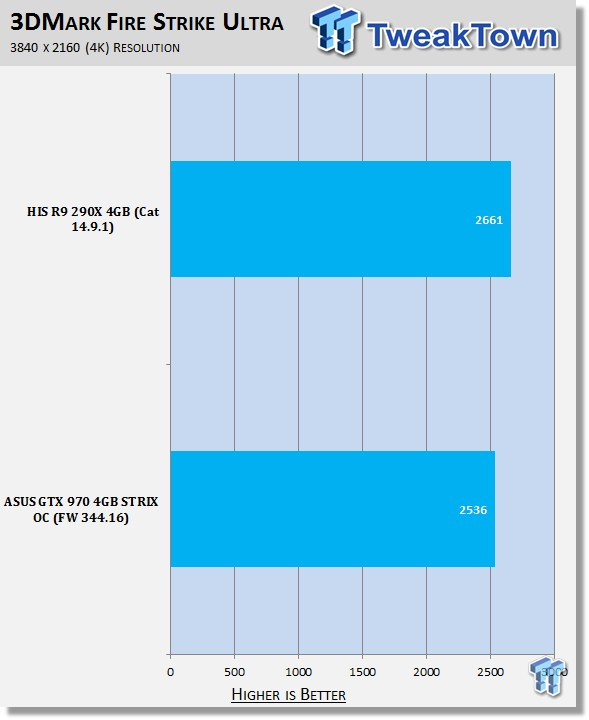
Moving into our 4K resolution benchmarks, and starting off with 3DMark Fire Strike Ultra, you can see that while both setups perform quite close to each other, the AMD R9 290X 4GB does manage to sneak out slightly ahead.
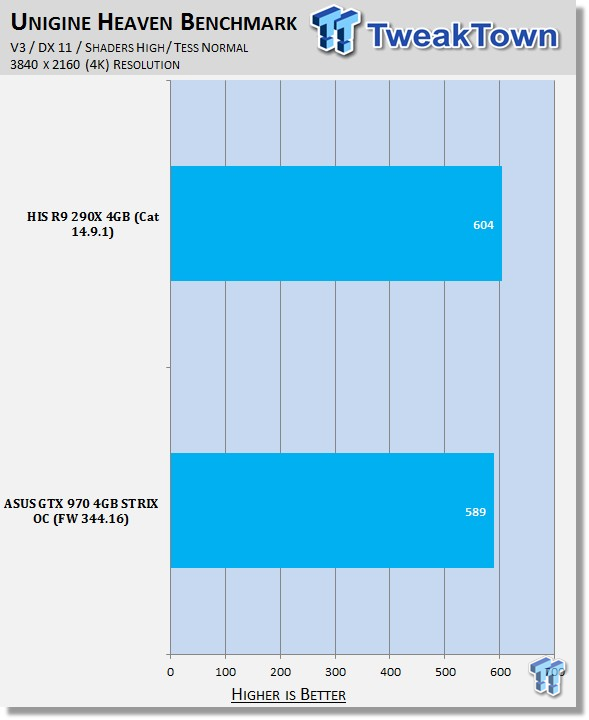
Looking at our second synthetic 4K benchmark, you can again see that while the two setups are very close to each other, the R9 290X 4GB does manage to sneak out slightly ahead of the ASUS GTX 970 4GB STRIX OC.

Looking at Shadow of Mordor, you can see that the R9 290X 4GB manages to have a strong performance gain over the ASUS GTX 970 4GB STRIX OC again. However, with that said, you can see the performance of both setups at this resolution is just way too low. You really do need a dual video card setup to get playable FPS here.
Benchmarks - 4K - 3840 x 2160 Testing Continued

Looking at Hitman: Absolution, you can again see that while the R9 290X 4GB does manage to have the performance lead, both setups struggle to hit playable FPS at this massive 4K resolution.

Tomb Raider continues the trend of the R9 290X 4GB coming out ahead, but overall, the performance numbers are just too low for both setups here.

Finishing up our testing, we can see that in this instance the ASUS GTX 970 4GB STRIX OC manages to sneak out the win. What's consistent, though, is the fact that the FPS are just too low for the game to be playable.
Temperature & Sound Testing
Temperature Test

The temperature of the core is pulled from MSI Afterburner with the max reading used after a completed run of 3DMark Vantage at the Performance preset.
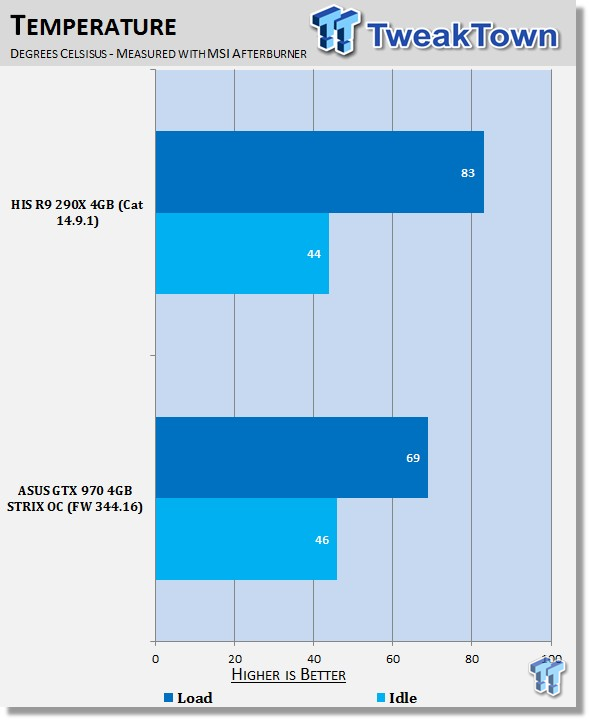
In comparison to the reference R9 290X 4GB cooler, you can see the ASUS STRIX DirectCU II unit does a fantastic job of keeping the numbers under control. While the idle numbers are similar, you can see the load numbers are a solid 14c cooler.
Sound Test

Pulling out the TES 1350A Sound Level Meter, we quickly find ourselves yelling into the top of it to see how loud we can be.
After five minutes of that, we get a bit more serious, and place the device two CM away from the fan on the card to find the maximum noise level of the card when idle (2D mode), and in load (3D mode).
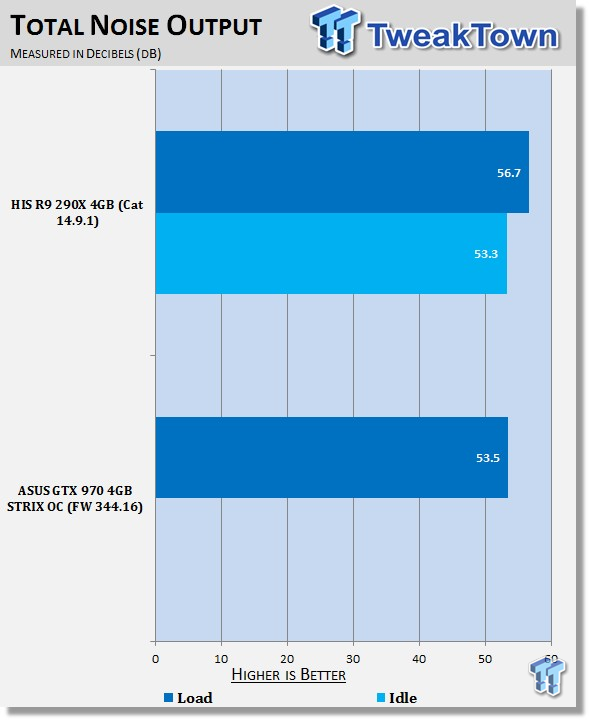
What's even better is that the lower load numbers come in with less noise. As for the idle noise levels, the card fortunately doesn't output any noise since the fans do not need to spin.
Power Consumption Testing

Using our PROVA Power Analyzer WM-01 -or "Power Thingy" as it has quickly become known as to our readers- we are now able to find out what kind of power is being used by our test system and the associated video cards installed. Keep in mind that it tests the complete system (minus LCD monitor, which is plugged directly into AC wall socket).
There are a few important notes to remember, though. While our maximum power is taken in 3DMark06 at the same exact point, we have seen the power being drawn as much as 10 percent more in particular tests. We test at the exact same stage every time, so tests should be very consistent and accurate.
The other thing to remember is that our test system is bare minimum -only a SSD is used, with a single CD ROM, and minimal cooling fans.
So, while the system might draw 400 watts in our test system, placing it into your own PC with a number of other items will result in a higher draw.
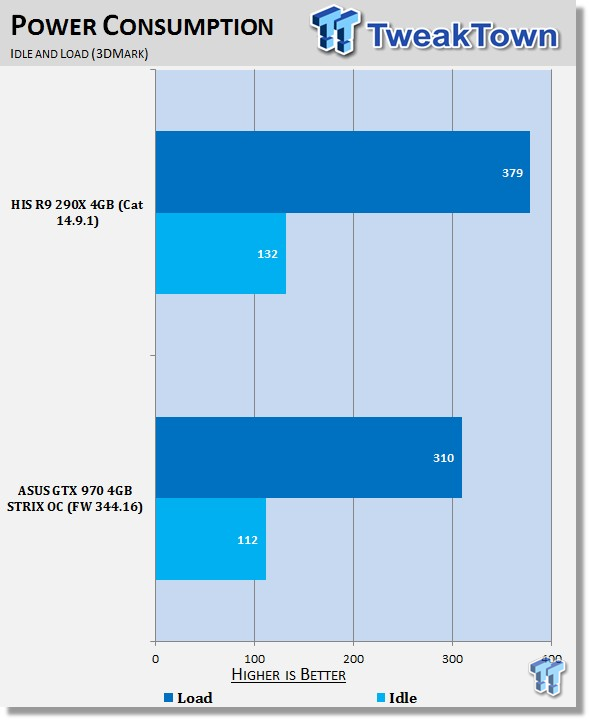
Power draw is also significantly better on the ASUS GTX 970 4GB STRIX OC in comparison to the R9 290X 4GB. We see a solid decrease in power draw in both the idle and load department.
Pricing, Availability, and Final Thoughts
When the GTX 970 4GB launched just last month, the price difference between it and the R9 290X 4GB was quite significant. Considering the performance of the card ,and the cheaper price point, it was a no brainer when it came to picking the new Maxwell based GPU over the AMD offering.
Jump forward a month, and throw in a significant price drop that sees the R9 290X 4GB come in at about the same price point as the GTX 970 4GB, and it's still a no brainer. While both cards perform similarly, and at times the R9 290X 4GB does manage to take out the win, the simple fact is that people don't want to buy a card that is a year old.
When it comes to performance and value, buying the R9 290X 4GB over the GTX 970 4GB wouldn't be as horrible of a choice now as it was just a month ago. The problem is: people don't want to buy a card that is so old now. In terms of technology, a year is a long time. AMD will also eventually release new cards (sooner than later), and the focus will move away from these R9 offerings. NVIDIA, on the other hand, will be concentrating on improving the performance of the GTX 900 series through drivers for quite a while.
One area we do see the similarly priced GTX 970 4GB fall behind consistently is at the massive 4K resolution. If you're wondering what card you should get if you're interested in gaming at 4K, then wonder no longer. While the R9 290X 4GB might seem like the easy choice, the simple fact is both cards can't give us the FPS we need when only one is used.
As for how the STRIX version of the GTX 970 4GB compares to others: it's solid. We really haven't had a chance to look at many versions of the card, but we know we're fans of it, as it offers some great value for money. Although, the STRIX version is really a step ahead when it comes to silent gaming. ASUS is really one of the only companies, if not the only company, that offers the ability to game silently on the new GTX 900 series.
While other companies offer a fan that doesn't spin when you're just cruising around your desktop, as soon as you do any form of gaming, the fans start to spin up. On the other hand, the ASUS STRIX version only spins up when more intensive gaming is underway. If you're playing something older, or just something that isn't quite as intensive, the fan will refrain from spinning while you're gaming.
While the package is a bit on the light side in terms of extras, this is fairly standard, as companies prefer to throw all their effort into the card itself. When it comes to this card, ASUS has done a really good job. We've got a nice core overclock out of the box, a solid cooler that really stands out for all the right reasons, and a price point that is perfect for a lot of people.
PRICING: You can find the ASUS STRIX-GTX970-DC20C-4GD5 Graphics Cards STRIX-GTX970-DC20C-4GD5 for sale below. The prices listed are valid at the time of writing but can change at any time. Click the link to see the very latest pricing for the best deal.
United States: The ASUS STRIX-GTX970-DC20C-4GD5 Graphics Cards STRIX-GTX970-DC20C-4GD5 retails for $452.06 at Amazon.
Canada: The ASUS STRIX-GTX970-DC20C-4GD5 Graphics Cards STRIX-GTX970-DC20C-4GD5 retails for CDN$784.99 at Amazon Canada.

| Performance | 92% |
| Quality including Design and Build | 95% |
| General Features | 95% |
| Bundle and Packaging | 85% |
| Value for Money | 90% |
| Overall | 91% |
The Bottom Line: While AMD dropped the price on the Radeon R9 series, they lack that new card smell that is present on the Maxwell series from NVIDIA. Combining Maxwell with the ASUS STRIX features, helps make the ASUS GTX 970 4GB STRIX OC a great video card for people wanting a card that offers fantastic performance with impressive noise and power numbers.
PRICING: You can find products similar to this one for sale below.
 United
States: Find other tech and computer products like this
over at Amazon.com
United
States: Find other tech and computer products like this
over at Amazon.com
 United
Kingdom: Find other tech and computer products like this
over at Amazon.co.uk
United
Kingdom: Find other tech and computer products like this
over at Amazon.co.uk
 Australia:
Find other tech and computer products like this over at Amazon.com.au
Australia:
Find other tech and computer products like this over at Amazon.com.au
 Canada:
Find other tech and computer products like this over at Amazon.ca
Canada:
Find other tech and computer products like this over at Amazon.ca
 Deutschland:
Finde andere Technik- und Computerprodukte wie dieses auf Amazon.de
Deutschland:
Finde andere Technik- und Computerprodukte wie dieses auf Amazon.de
Similar Content
Related Tags
